KIYOKO ITÕ – Hoshi Kara No Tayori
CBS/Sony – SONA 86009 Released 1968
Track A – Hoshi Kara No Tayori (A Letter From The Stars)
Here is a “drifty” sweet release from Kiyoko Ito with a beautiful sprinkling of psychedelia. Perhaps more tempered and whimsical than my normal up beat dancers from the sixties gals, but it’s too good to not share this one!
There’s not very much I can find on Kiyoko, other that she was born on January 24, 1947, possibly in the northern island of Japan, in Sapporo, Hakkaido. After graduating from Aoyama Gakuin High School in 1964, she entered Takarazuka Music School. She passed the audition for Toho’s International Dancing Team and appeared as a dancer in the musical “No Strings” in June, but gave up dancing due to Achilles tendonitis. As a result, she dropped out of the music school.
Focusing on the folk songs that were popular among Japanese youth at the time, she decided to become a singer, and made her debut at the 1st Folk Song Festival held at The Nippon Theater on December 19, 1965. The following year, in May 1966, she passed the audition (of over 300 Japanese singers) for the popular American folk group New Christie Minstrels and became an official member. A group not really to my tastes, but they did have have amazing talent go through the ranks, such as Kim Carnes and Kenny Rogers. She went straight to the United States and remained with the group until her Visa expired in October.
 After returning to Japan, she signed a contract with Watanabe Preofessionals, and had her debut single in June1967 on Nippon Columbia’s CBS label with the song “Hana to Kojisan” written by Kurunosuke Hamaguchi . This became her first hit! For some reason, I cannot find this in any of her catalogue listings, let alone a recording or clip, but I’m sure it’s out there somewhere. I’m sure it’s just lost in translation. Ito then would go on to record twelve 7″ singles with the CBS/Sony label, as well as three albums, between 1967 to 1975.
After returning to Japan, she signed a contract with Watanabe Preofessionals, and had her debut single in June1967 on Nippon Columbia’s CBS label with the song “Hana to Kojisan” written by Kurunosuke Hamaguchi . This became her first hit! For some reason, I cannot find this in any of her catalogue listings, let alone a recording or clip, but I’m sure it’s out there somewhere. I’m sure it’s just lost in translation. Ito then would go on to record twelve 7″ singles with the CBS/Sony label, as well as three albums, between 1967 to 1975.
This featuring track “Hoshi Kara No Tayori” (A Letter From The Stars), is actually the B side to her euphonious upbeat Mishiranu Sekai single, one of three releases from 1968. Both sides of the single also appear on her 1969 LP Ballads Of Love. The year 1968 and sitars go hand in hand, and so many pop artists would experiment with introducing this sound with at least one song release of that year. And I’m ever so thankful for that! The trippy sitar introduces the song, a beautiful flavor that mixes in with the percussion and that 60’s bass that soon enters. A sweeping harp, then we receive Ito’s voice. I really wish I had a translation to this song. Of course it’s not always needed, especially in this case, as we are taken away and fall lusciously into her vocal clouds, but I do imagine the lyrics are about spirit, love and innocence. And it does after all translate to A Letter From The Stars.
As far as other release from Kiyoto Ito that take me away to that faraway dreamy place, she released the beautiful “Namida no Binzume” as a 1969 single, and is just as delightful as the featured track, sans sitar and psychedelics. This track also appears on the Ballads Of Love LP. I also love “Hana No Madonna” also from 1968, and a bit more of a dancer. And for your exotica lounge soiree, the 2 sider “Talking To Myself” and “Soon Will Be Morning” 7 inch from 1972, is an absolute goodie!
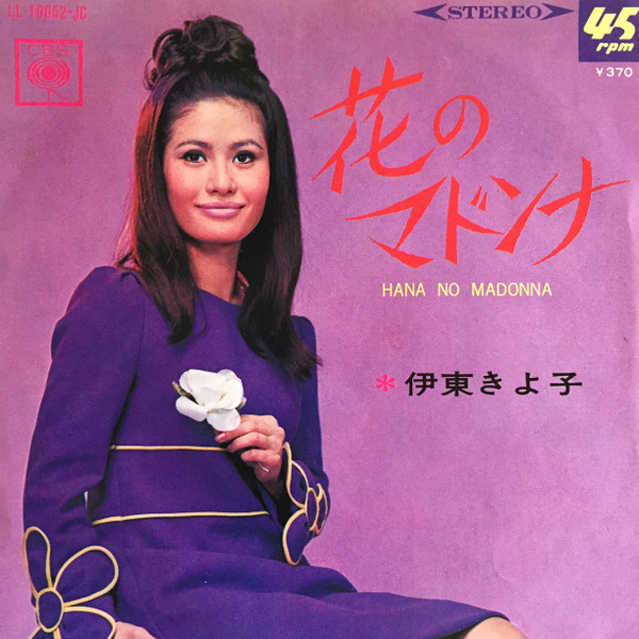

So there you have Kiyoko’s sweet, psychedelic love song release, and after a few listens, like a whispering haze, I’m sure it will seep delightfully into beating heart. I would love to be enlightened on anything more about this wonderful singer, from anywhere out there in the world.
– DJ del Piero
Maki Asakawa – Chicchana Toki Kara
Express Compact ETP-4277 Japan 1970

 Track 1 – B2 Chiccana Toki Kara
Track 1 – B2 Chiccana Toki Kara
Track 2 – A1 Yoru Ga Aketara
Maki Asakawa was a born in Ishikawa Prefecture, January 27, 1942. After graduating high school she worked as a civil servant for a short time before moving to Tokyo to pursue a far more inspirational career in music. She started by playing at United States military bases and cabarets, where she refined her style, which she says was largely influenced by Blues queens such as Billie Holiday and Mahalia Jackson.
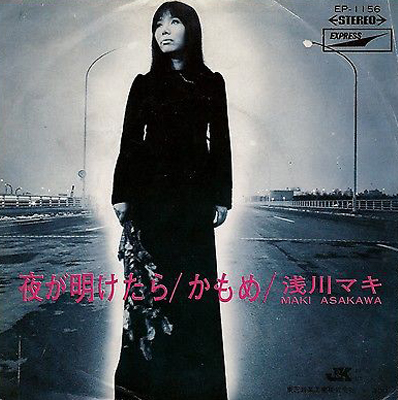 In 1967 Asakawa made her debut recording, releasing Tokyo Banka with B side Amen Jiro on Victor. In 1968, Asakawa got her big break when she appeared for three days running at the Shinjuku underground theater known as Sasoriza, a project of underground playwright Shuji Terayama. She soon signed with Toshiba, and by the next year had released the very, VERY cool and slick Yo ga aketara (At the Break of Dawn) and Kamome (Gull) on Toshiba’s subsidiary Express label.
In 1967 Asakawa made her debut recording, releasing Tokyo Banka with B side Amen Jiro on Victor. In 1968, Asakawa got her big break when she appeared for three days running at the Shinjuku underground theater known as Sasoriza, a project of underground playwright Shuji Terayama. She soon signed with Toshiba, and by the next year had released the very, VERY cool and slick Yo ga aketara (At the Break of Dawn) and Kamome (Gull) on Toshiba’s subsidiary Express label.
1970 saw this featured Asakawa release, which has as the B2 track, Chicchana Toki Kara. This wonderful, yet not easy to find EP, has to be my favourite from Maki, with it’s big beat drive, high energy horns and cinematic production. Every time I play this I get comments as to how hasn’t Tarantino used this track for one of his movies. It’s 70’s sex, has a good amount of sting, and would be the ideal punch for a strong femme fatale introduction. And having the slow swinging Yo Ga Aketara as the opening track makes this 7″ a real delight (that distant train at the end…I mean really, what a way to see out such a cool track). Just the thought of seeing this performed in a dark underground club of Tokyo by Maki and that time just does my head in. The smoke, the black, the neons and the distant traffic outside…not too difficult to visualize. But this wasn’t just a time for Asakawa’s musical exploration.
In 1971, Asakawa made her big screen debut when she played the stairway prostitute in Shuji Terayama’s experimental Throw Away Your Books, Rally in the Streets. It was the first film for poet-playwright Terayama, and it was about an angst-ridden teen who hits the streets after dealing with his dysfunctional family. This hard to find movie has a strong underground following due to it’s non-linear Avant-Garde vision and amazing pre-punk psychedelic soundtrack. Asakawa’s recording of Nemuru No ga kowai is included amongst the tracks, and can also be found on her 1971 Maki II album, which by the way also include covers of Gin House Blues and The House Of The Rising Sun. That great LP also happens to include the incredible psychedelic Govinda (there should be a link below)…such a stand out Asakawa composition! The next year in ’72, Asakawa would release Blue Spirit Blues, and again here her voice somehow feels so right within the warm minor chords.
 In 1973 Asakawa would this time hit the small screen on the dark Japanese TV Series Kyôfu Gekijô Umbalance. From what I can put together, she appeared in season 1 episode 7, and I’m almost certain the link below is the clip from that episode, where she plays herself singing Yo Ga Aketara, on a cinema screen in a dark seedy theater, and with the dark seedy characters to match.
In 1973 Asakawa would this time hit the small screen on the dark Japanese TV Series Kyôfu Gekijô Umbalance. From what I can put together, she appeared in season 1 episode 7, and I’m almost certain the link below is the clip from that episode, where she plays herself singing Yo Ga Aketara, on a cinema screen in a dark seedy theater, and with the dark seedy characters to match.
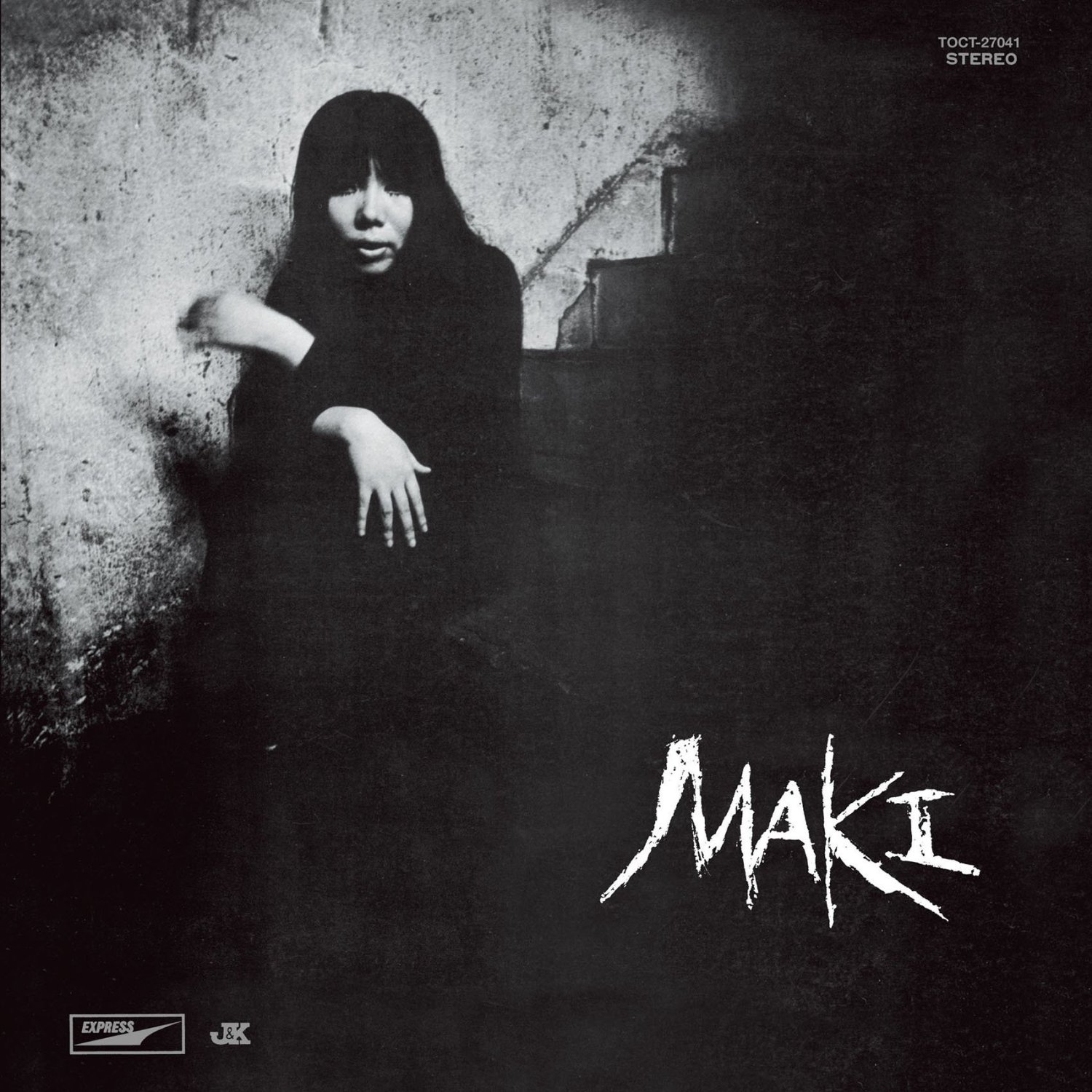 Over the next 30 or so years, Asakawa recorded quite a lot of records, but it wasn’t all dark moody blues and folk jazz. I discovered the Catnap album through a favourite blog, Interstellar Medium – Foriegn Lavish Sounds, which you should hit up, for a far more detailed look into the great album. Released in 1982, it’s a colourful, bold yet smooth collision of electronic jazz funk post punk plus, and for myself, it was so exciting to discover this side of Asakawa. The opening track Kurai Me Wo Shita Joyuu and also Shinkyoku B are real high lights, if I was forced to choose. This album holds up to quite high to today’s very standard standards in my opinion.
Over the next 30 or so years, Asakawa recorded quite a lot of records, but it wasn’t all dark moody blues and folk jazz. I discovered the Catnap album through a favourite blog, Interstellar Medium – Foriegn Lavish Sounds, which you should hit up, for a far more detailed look into the great album. Released in 1982, it’s a colourful, bold yet smooth collision of electronic jazz funk post punk plus, and for myself, it was so exciting to discover this side of Asakawa. The opening track Kurai Me Wo Shita Joyuu and also Shinkyoku B are real high lights, if I was forced to choose. This album holds up to quite high to today’s very standard standards in my opinion.
As Maki Asakwa grew older, she never stopped performing live. Just before an appearance on January 15-17, 2010 where she had a concert in Nagoya, she died of heart failure before the show could go on. She was 67.
References and inspirations…
Jacqueline Taïeb – 7 heures du matin
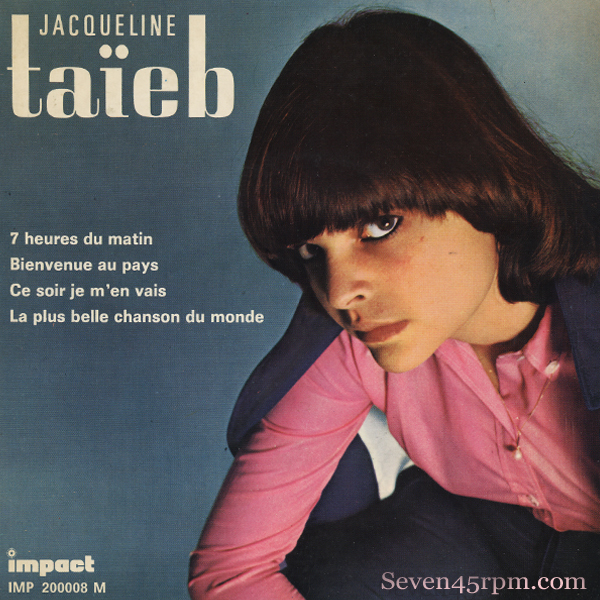
 Impact IMP 200008 M France 1967
Impact IMP 200008 M France 1967
Track 1 – 7 heures du matin Track 2 – Ce Soir Je M’en Vais
Born 1948 in Carthage, Tunisia, the young Taïeb arrived in France with her parents at age eight. Her father gifted her with a guitar at 12 (like every good dad should do) which she must have really connected with, because soon she would be composing her own songs. It wasn’t long before a talent scout would discover her while singing with friends. It was ’66, and what an exciting time it must have been for the big eyes of 18 year old singer-songwriter, scoring a contract with the record label Impact, and then being quickly whisked away off to London for her first recording sessions.
1967 saw a string of 7″ releases for the then 19 year old Jacqueline, but it’s this debut EP release (in January) that she is most well worshiped for. All four songs on the EP were composed by the young singer herself, which you have to remember for that time, was quite rare, as most female singers were expected to perform songs that had been written for them, or perhaps covers of other popular high selling hits.
Though the lead track, the almighty ye ye classic 7 heures du matin, was only a small hit at the time, it has gone on to become considered a classic of the French girl pop genre. It is the story of a young student waking up too early, at 7am, on a Monday morning, struggling with the thoughts of what the day will throw at her. She fantasizes about her boy crush Paul McCartney, helping her complete her homework, while tormenting on which sweater to wear for the day. Obviously a girl who is after trouble, the rebellious girl even considers playing her Elvis record loudly just to upset the neighbors. I mean really…how cute is that!?
It’s a simple song, but a huge dance floor monster! With it’s Steppin’ Stone garage power chords and it’s rebellious Elvis meets The Who attitude, it’s freakin’ impossible not to adore this one! And obviously very high in demand in the collectors circle. This track really brings back some great memories of the Sounds Of Seduction nights we once were fortunate to encounter here in Sydney in the 90’s, hosted by the great Jay Katz, (a friend who is responsible for introducing me to so much great lost European dance and film music of the sixties). And this song was also the trigger to the beginnings of my Ye ye obsession!
Update! A few years back I managed to get my hands on the elusive Australian issue of this masterpiece, with both 7AM and the flip side, which translates to Tonight I’m Going Home, sung in English! And finally getting a chance to upload. I love both these English renditions, even as a purist to the French originals! This issue has a catalogue date set to 1968.


W & G – WG-S-8124 Australia 1968
Side A – 7 am.
Side B – Tonight I’m Going Home
More Jacqueline Taieb 7″s to come as well a whole lot more Ye Ye!!!
Sylvie Vartan – Ne T’en Vas Pas

 RCA Victor 86.019 France Year 1963
RCA Victor 86.019 France Year 1963
Prolific French ye ye singer Sylvie Vartan, who is actually Bulgarian, really does a nice swinging beat cover of the classic Comin’ Home Baby. Although it was originally recorded by the Bob Dorough Quartet in 1961 on Two Feet in the Gutter (Epic BA 17021) and composed by Ben Tucker (Bailey’s Pianist), it’s the ultra cool and hip Mel Torme version that most people know and love. Bob Dorough of School House Rock Fame added lyrics to the song and the vocal version became a Top 40 hit for the American jazz man, but I find Vartan’s more obscure version which was released in ’63, even more exciting!
Sylvie started her professional singing career while still at school, in her late teens, firstly with the hit song “Panne d’essence” (1961) alongside French rocker Frankie Jordan. Dubbed by journalists as “la collégienne du twist” (the twisting schoolgirl) she quickly started attracting a lot of attention, and it was only a matter of time that this young self confessed jazz/rock n’ roll fanatic, got signed up and began her illustrious recording career. In 1963, Paul Anka offered her “I’m watching”, her first international hit (Japan, Korea) which is the opening B side track of this EP. It’s adorably sweet and quirky with her broken English vocals, and holds a pretty respectful beat! That same year her dreams of being an aspiring actress came true, starring in the movie D’où viens-tu, Johnny? alongside french rock legend Johnny Hallyday, who she toured with in France and ended up marrying in 1965. Six of her thirty-one songs released in 1962/1963 became top 20 European hits and she became the darling of teen magazines and TV, so suffice to say this was an exciting and pivotal moment in her early career!
So back to Ne T’en Vas Pas! The back beat is strong and mean, as it should be, although I do wish it was pushed up in the mix a bit more as with the driving bass (you dj’s will be doing just that on your mixer) and I love the high energy modish Hammond solo. I have to say I always find French female vocal translations of standards or other, so much more attractive and desirable (this is not open for debate!) and Vartan’s approach on this makes it so ultra sexy and worthy! As far as I can tell, it doesn’t look like this recording was ever released on any other 7″ format other than the picture RCA EP. Maybe some foreign presses were released? Not too difficult to find and highly recommended!

 Also check out Sergio Mendes’ great Latin instrumental version of Comin’ home baby (Atlantic 45 2572) and Vartan’s great “Gimme some lovin'” cover Donne Moi Ton Amour!
Also check out Sergio Mendes’ great Latin instrumental version of Comin’ home baby (Atlantic 45 2572) and Vartan’s great “Gimme some lovin'” cover Donne Moi Ton Amour!
France Gall – ZOZOI

 La Compaigne S-103 1970 France
La Compaigne S-103 1970 France
Born Isabelle Genevieve Marie Anne Gall 09.10.1947
I discovered this french chic many years ago searching through some old records in Paris, during my honeymoon. I couldn’t play my purchases until we returned back home, here in Australia, on the other side of the world, but when I finally did put down the needle to the vinyl, I was hooked on her…and still am to this day! What an amazing talent!
So much can be said about Gall, it’s fair to say the queen of the “ye ye” genre, but she is so much more. Having musical success from the age of 16, then soon collaborating with the legendary genius Serge Gainsbourg, and married to the late and great Michel Berger, this little lady, while quite prolific and mainstream, proved to be quite a power house vocalists, with a versatility that ranged from playful innocent teen pop, to scatty jazz and then more. Way too much to talk about in regards to this amazing woman here, but let’s just say her 60’s career was a bumpy ride. Although winning some worthy successful hits, a few of her recordings were marred with controversy and bad taste (thanks to Mr. Gainsbourg), not helping the young innocent and naive artist, and resulted in poor sales. But having said that, there is no Gall recording I don’t love, and I will have to do a special feature on her and her career some time soon.
So let’s talk ZOZOI! Easily the most sought after 45 of hers and rightly so. Released on La Compaigne, a new label for Gall, this is a contrast to her early sixties sweet pop and “yeye” recordings. Here, she is really turning on the seductive and steamy vocal chords in this latin bossa bonanza. Penned by her father-lyricist Robert Gall, recorded with the Brazilian master Pianist Cesar Camargo Mariano and his Sambalanço Trio, this is definitely new ground for her and is she just loving it. According to musicaltaste.com, while the band recorded in Brazil, the vocals were overdubbed later in France. Not an easy one to find in today’s market, but even rarer is the fantastico Italian vocal version, and I mean RARE! Sadly, I don’t have it, but really want it, so if you have a spare copy, I’ll be happy to take it! Released in 1970, it’s a must have! It’s French, it’s Latin, it’s Brazilian, it’s Tropicalia, and with that great horn section and that tempo, it’s as hot as this sweet little lady gets!
Music credits also go to Nelson Angelo.
Other France Gall recommendations…..
Le Temps du Tempo (1968), Jazz a gogo (1964) and Laisse tomber les filles (1964).
Highly recommended yeye website….


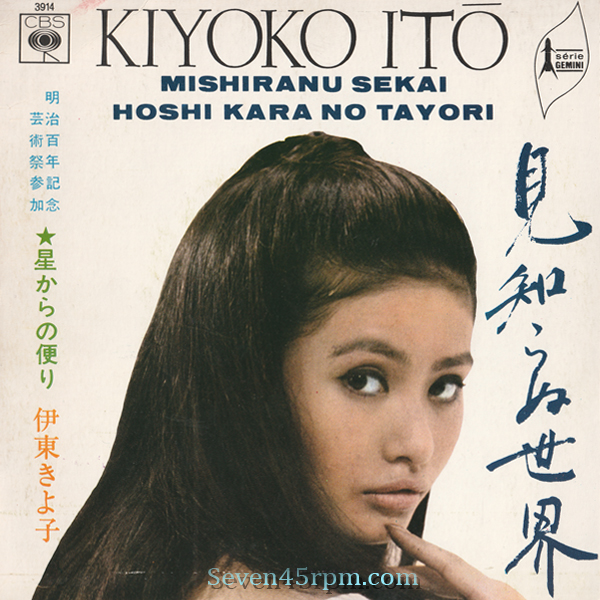





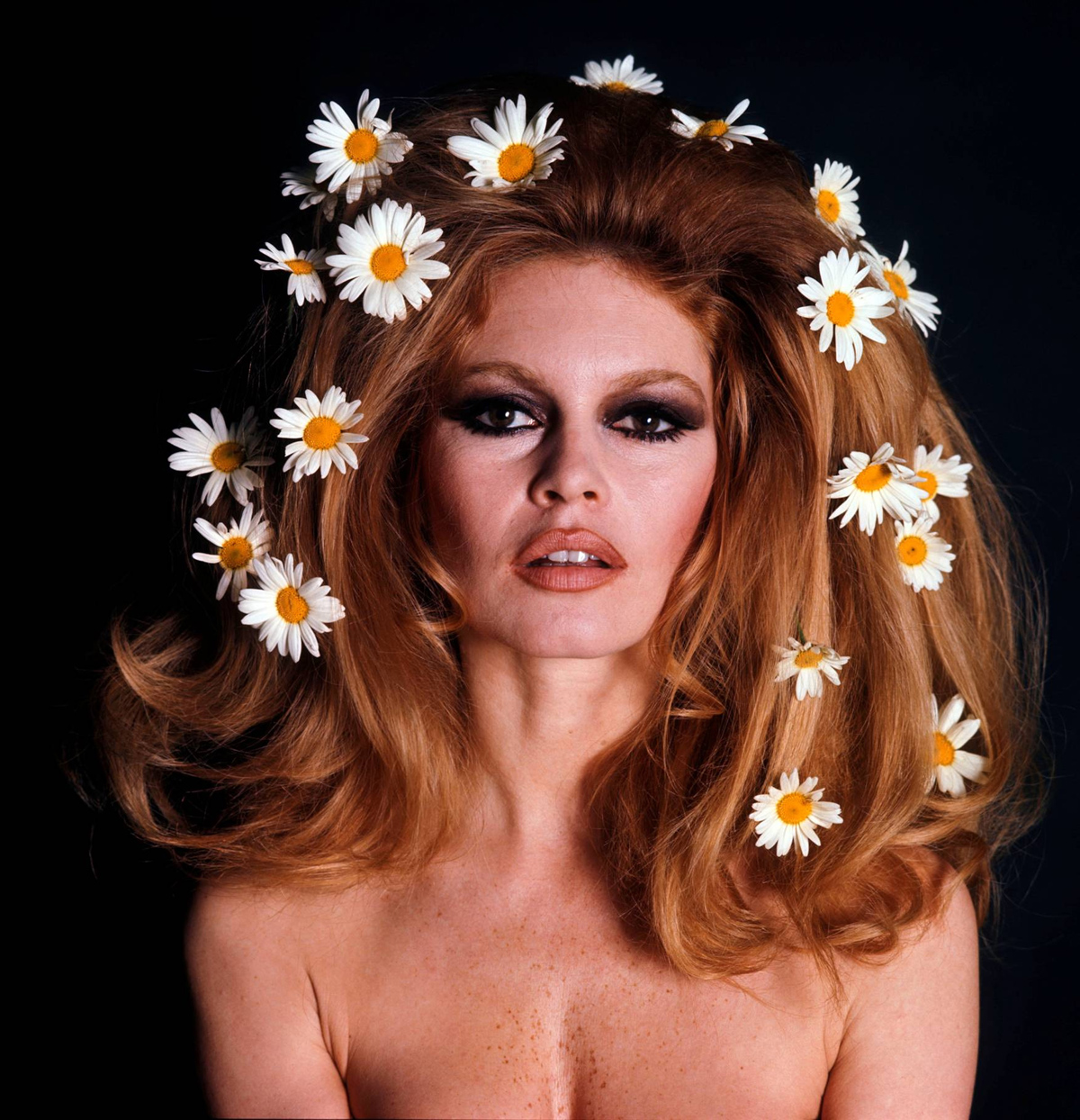
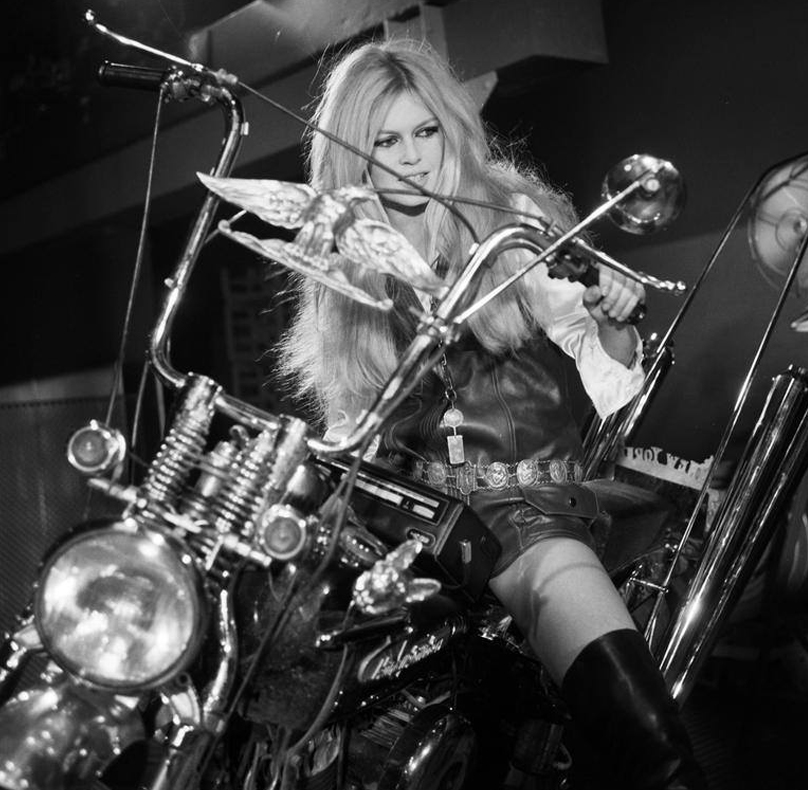



Recent Comments